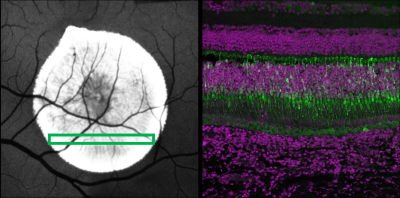
These images are the results of a subretinal injection. Left is the image of the injection site in the retina, the green box indicates the plane in which the right image was taken. Right is the immunofluorescence image of the retina section, with green indicating transfected cells and purple indicating all cell nuclei. Image credit: Oregon State University.
Researchers who work with tiny drug carriers known as lipid nanoparticles have developed a new type of material capable of reaching the lungs and the eyes, an important step toward genetic therapy for hereditary conditions like cystic fibrosis and inherited vision loss.
Unlike other types of lipid nanoparticles that tend to accumulate in the liver, the ones in this study, based on the compound thiophene, are able to navigate their way to the tissues of the lungs and retina, where they deliver their therapeutic payload. The researchers refer to these new lipids as Thio-lipids.
The collaboration demonstrated, by using animal models, the possibility of using Thio-lipids in lipid nanoparticles to deliver messenger RNA, the technology underpinning COVID-19 vaccines, to combat genetic blindness and pulmonary disease.
As a therapy for vision impairment resulting from inherited retinal degeneration, the mRNA would instruct cells in the retina – which don’t work right because of a genetic mutation – to manufacture the proteins needed for sight. Inherited retinal degeneration, commonly abbreviated to IRD, encompasses a group of disorders of varying severity and prevalence that affect one out of every few thousand people worldwide.